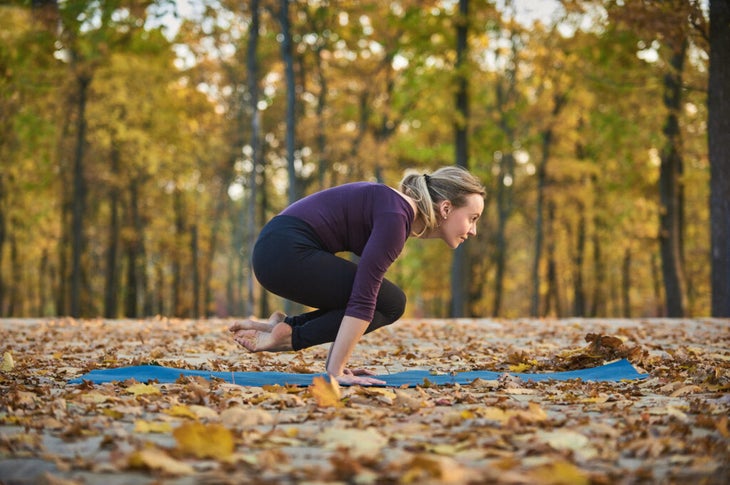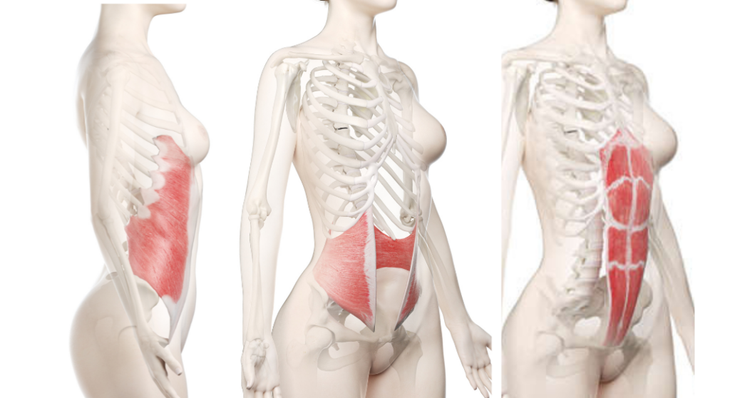Heading out the door? Read this article on the new Outside+ app available now on iOS devices for members! Download the app.
Many of us equate “core strength” with strong abdominal muscles. So we practice endless reps of sit-ups and poses in yoga that intensively work the abdominal muscles to develop it. Although the most commonly taught core-strengthening pose in most yoga classes, often to a chorus of groans and sighs, is Boat Pose (Paripurna Navasana).
The oft-overlooked Pendant Pose (Lolasana) is another option.

What Is Lolasana?
Lolasana is called Pendant Pose for a reason: Your body literally dangles between your arms and may even swing a little. From kneeling on the mat, you place your hands beneath your shoulders, spread your fingers wide, and shift your weight into your hands as you cross your ankles (or not) and lift your knees and feet off the mat and draw them toward your chest.
Sounds easy? Try it. You’ll quickly feel that it requires a tremendous amount of strength and coordination. As a result, the pose is effective for strengthening all of the abdominal muscles, most of the hip flexor muscles, and several shoulder muscles. It also places extraordinary demands on the external oblique abdominals, making it adept at strengthening the often-overlooked side body.
Benefits of Lolasana
Lolasana, like other poses that strengthen your abdominals and hip flexors, improves your ability to keep your chest, back, and abs stable while you move your arms and legs into various positions in your yoga practice. This stability is essential for finding steadiness and preventing back pain.
But Lolasana offers some added perks that Boat Pose and sit-ups don’t include. It strengthens your arms and shoulders and trains your nervous system to coordinate that strength with powerful abdominal and hip flexor action. This provides the foundation for projecting power forward through your arms and legs, which you also need to do in everyday life.
Lolasana also benefits your yoga practice by preparing you for other arm balances and jump-throughs .
How Lolasana Works
All of your abdominal muscles are strengthened. As they contract in Pendant Pose, they draw the front of your pelvis toward the front of your rib cage and curl your hips and trunk into a ball. At the same time, your hip flexors engage to draw your thighs toward your chest.

External obliques, internal obliques, and rectus abdominis muscles. (Illustration: Eraxion)
Three sets of abdominal muscles work together to provide the pelvic lift in Lolasana: the rectus abdominis, the external obliques, and the internal obliques. The net effect of this complex arrangement of muscles is that the simultaneous contraction of these muscles draws the pelvis strongly upward toward the ribs and flexes the lumbar spine to create much more lift in your front body than in back.
The rectus abdominis are the muscles that people refer to when they talk about “six-pack abs.” It is composed of several segments embedded in a sheath of tough connective tissue that connects the base of the sternum (the xiphoid process and nearby cartilage) to the middle of the lower front pelvis (the pubis).
The external oblique abdominal muscles run alongside the rectus abdominis and cover the remainder of the front of the waist, the sides of the waist, and part of the back waist. Their fibers attach to the sides of the lower rib cage and run diagonally down and forward to attach at the other end to the rectus sheath in front or to the top rim of the pelvis in back.
The internal obliques lie underneath the external and run diagonally down and backward, roughly perpendicular to the fibers of the external obliques.
Although all of the abdominal muscles contribute to lifting the lower body, the work of the external obliques is especially intense. When the obliques contract, they draw your chest forward. This is because their frontal fibers connect directly to the side ribs, pulling them downward and inward.
The oblique abdominals prevent the ribs from swinging too far forward. They also translate the lifting power of the serratus muscles into elevating the abdomen and hips. This means that to do Lolasana effectively, you have to pay special attention to contracting the front sides of your waist.
How to Lift Your Legs in Lolasana
When you’re learning the basic shape of Lolasana, it helps to focus first on your arms, chest, and shoulders. Relax your abdomen and hips, allowing your pelvis and legs to hang so all the work is in your upper body.
Notice that the triceps muscles on the backs of your upper arms tighten to straighten your elbows, and two other muscle groups—the pectorals, on the front of your chest, and the serratus anterior muscles, which run from your inner shoulder blades to your side ribs in front of your armpits—work together to lift your rib cage upward. This upward pull tends to make your ribs swing up and away from your dangling pelvis, similar to the movement they make when you inhale deeply.

Let’s take a closer look at how to get your legs off the mat in Lolasana. The core muscle that does most of the heavy lifting here is the iliopsoas, which is composed of two deep hip flexors: the iliacus and the psoas. Several superficial hip flexors also lend an assist.
Because the hip flexor muscles are anchored to the pelvis or the lower spine, you can lift your legs off the floor only if the front of the pelvis remains lifted and you hinge forward at your hips. The abdominal muscles are critical to achieve this lift and flexion. If they are too weak, the front of the pelvis will sag, the spine will lose its flexion, and the legs will droop toward the floor.
Of course, the hip flexors have to be strong, too. If they are too weak, you won’t be able to lift your legs, no matter how high you raise your pelvis and spine.
How to Practice Lolasana
The best way to learn Lolasana is to gradually increase the level of challenge as you grow stronger. You’ll want to attempt Lolasana following a well-rounded practice that prepares your body and mind by first working your arms, core, and spine.
Prepare for Lolasana Using a Chair
You can also practice the following exercise while seated in a chair.
How to:
- Sit in a sturdy chair, place your hands on the seat on either side of your hips, lean forward about 45 degrees, and push down firmly to take most of the weight off your pelvis.
- Exhale and push your hands down more as you lift your thighs upward as if to draw them toward your chest. Your abdominal muscles connect your rib cage to your pelvis, so you’ll feel your abs engage as you attempt to lift the pelvis and ribs. Your front hip muscles connect your pelvis and spine to your thighs, so you’ll also feel those hip muscles engage, regardless of whether you lift your feet off the mat.
Lifting into Lolasana
It can take considerable practice to build up enough strength to lift into Lolasana. To make the pose more accessible—yet still plenty challenging—try a variation with blocks.
How to:
- Place two yoga blocks, shoulder-width apart, on the lowest level on the mat.
- Kneel on the mat with your knees between the blocks. Lift your pelvis off your feet. Place your hands on the blocks with the heels of the hands on the edge of the blocks. (Don’t put your hands too far forward, or the blocks might flip.) Cross your ankles.
- Lean forward and as you exhale, push firmly down with your hands and try to lift both feet off the floor. Move your shoulder blades apart to lift your body as high as possible, and at the same time, draw yourself into as tight a ball as you can by pulling your heels up and curling your trunk, bringing your thighs as close to your rib cage as they will go. Exhale fully as you contract your abdomen as tightly as you can.
- If you can, stay here and create a Cat Pose movement of your entire spine, curving the middle of your back up away from the floor. At first, you may need to look down at the ground, but once you’re balanced, gradually lift your head and, without straining or wrinkling your brow, gaze straight ahead.
- Swing your body gently forward and back for several breaths, and then come down. If you repeat the pose, cross the opposite ankle on top.
Variation: While you’re working toward Lolasana, leave your feet on the mat. As you push your arms down to lift your body, press the tops of your feet into the floor and unbend your knees partway to assist the lift. Use the pressure of your feet into the floor to help you draw your thighs close to your chest. Curl your trunk, just as you would in the traditional version of the pose. Now gradually push down less and less with your feet so your arms, abs, and hip flexors support you more and more. Challenge the limits of your strength by getting as close as possible to lifting your feet off the floor. Omit the swinging action at the end.
This article has been updated. Originally published February 26, 2010.